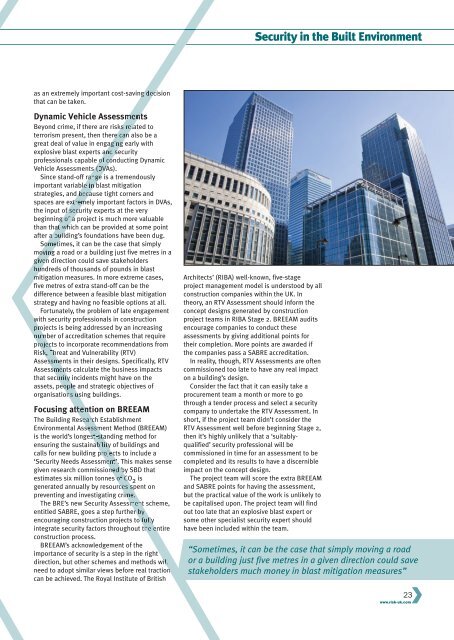RiskUKOctober2017
You also want an ePaper? Increase the reach of your titles
YUMPU automatically turns print PDFs into web optimized ePapers that Google loves.
Security in the Built Environment<br />
as an extremely important cost-saving decision<br />
that can be taken.<br />
Dynamic Vehicle Assessments<br />
Beyond crime, if there are risks related to<br />
terrorism present, then there can also be a<br />
great deal of value in engaging early with<br />
explosive blast experts and security<br />
professionals capable of conducting Dynamic<br />
Vehicle Assessments (DVAs).<br />
Since stand-off range is a tremendously<br />
important variable in blast mitigation<br />
strategies, and because tight corners and<br />
spaces are extremely important factors in DVAs,<br />
the input of security experts at the very<br />
beginning of a project is much more valuable<br />
than that which can be provided at some point<br />
after a building’s foundations have been dug.<br />
Sometimes, it can be the case that simply<br />
moving a road or a building just five metres in a<br />
given direction could save stakeholders<br />
hundreds of thousands of pounds in blast<br />
mitigation measures. In more extreme cases,<br />
five metres of extra stand-off can be the<br />
difference between a feasible blast mitigation<br />
strategy and having no feasible options at all.<br />
Fortunately, the problem of late engagement<br />
with security professionals in construction<br />
projects is being addressed by an increasing<br />
number of accreditation schemes that require<br />
projects to incorporate recommendations from<br />
Risk, Threat and Vulnerability (RTV)<br />
Assessments in their designs. Specifically, RTV<br />
Assessments calculate the business impacts<br />
that security incidents might have on the<br />
assets, people and strategic objectives of<br />
organisations using buildings.<br />
Focusing attention on BREEAM<br />
The Building Research Establishment<br />
Environmental Assessment Method (BREEAM)<br />
is the world’s longest-standing method for<br />
ensuring the sustainability of buildings and<br />
calls for new building projects to include a<br />
‘Security Needs Assessment’. This makes sense<br />
given research commissioned by SBD that<br />
estimates six million tonnes of CO 2 is<br />
generated annually by resources spent on<br />
preventing and investigating crime.<br />
The BRE’s new Security Assessment scheme,<br />
entitled SABRE, goes a step further by<br />
encouraging construction projects to fully<br />
integrate security factors throughout the entire<br />
construction process.<br />
BREEAM’s acknowledgement of the<br />
importance of security is a step in the right<br />
direction, but other schemes and methods will<br />
need to adopt similar views before real traction<br />
can be achieved. The Royal Institute of British<br />
Architects’ (RIBA) well-known, five-stage<br />
project management model is understood by all<br />
construction companies within the UK. In<br />
theory, an RTV Assessment should inform the<br />
concept designs generated by construction<br />
project teams in RIBA Stage 2. BREEAM audits<br />
encourage companies to conduct these<br />
assessments by giving additional points for<br />
their completion. More points are awarded if<br />
the companies pass a SABRE accreditation.<br />
In reality, though, RTV Assessments are often<br />
commissioned too late to have any real impact<br />
on a building’s design.<br />
Consider the fact that it can easily take a<br />
procurement team a month or more to go<br />
through a tender process and select a security<br />
company to undertake the RTV Assessment. In<br />
short, if the project team didn’t consider the<br />
RTV Assessment well before beginning Stage 2,<br />
then it’s highly unlikely that a ‘suitablyqualified’<br />
security professional will be<br />
commissioned in time for an assessment to be<br />
completed and its results to have a discernible<br />
impact on the concept design.<br />
The project team will score the extra BREEAM<br />
and SABRE points for having the assessment,<br />
but the practical value of the work is unlikely to<br />
be capitalised upon. The project team will find<br />
out too late that an explosive blast expert or<br />
some other specialist security expert should<br />
have been included within the team.<br />
“Sometimes, it can be the case that simply moving a road<br />
or a building just five metres in a given direction could save<br />
stakeholders much money in blast mitigation measures”<br />
23<br />
www.risk-uk.com

















